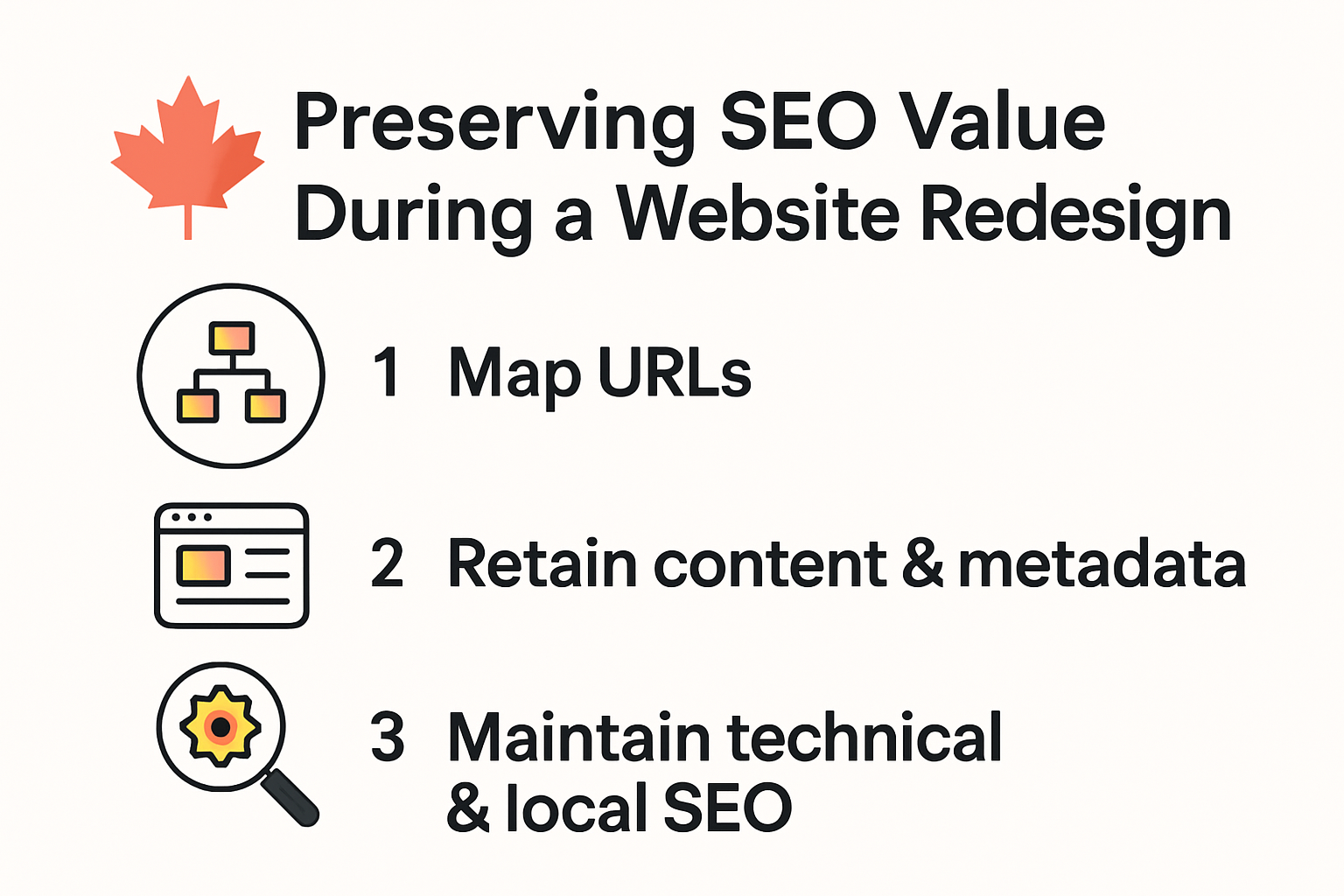Essential Website Redesign Checklist for Canadian Business Owners

Canadian business owners know a website can make or break your reputation today. You might think that simply having a website is enough to attract customers. Yet over 17% of web traffic now comes from mobile devices and most sites are still stuck in the past. A stale website is not just an eyesore, it could be quietly draining your sales and dropping you in search results, even if your business is thriving offline.
Table of Contents
Quick Summary
| Takeaway | Explanation |
|---|---|
| Redesign for User Experience | A website should provide a fast, intuitive experience to engage users effectively and reduce bounce rates. |
| Align with Brand Identity | Ensure your website reflects current branding and strategic goals to effectively communicate your business values. |
| Focus on SEO Preservation | Maintain SEO performance by implementing proper URL mapping and conserving existing content before a redesign. |
| Adopt Mobile-Responsive Design | Given that over 17% of web traffic is mobile, responsive design is crucial for reaching potential customers on all devices. |
| Implement Phased Redesign Approaches | Break the redesign into stages to manage costs effectively while making impactful changes incrementally. |
Key Reasons to Redesign Your Website
A website is more than just an online business card for Canadian entrepreneurs. It’s a dynamic digital platform that requires periodic updates to remain effective and competitive. Understanding the key reasons for a website redesign can help business owners make strategic decisions that drive growth and engagement.
Enhance User Experience and Performance
User experience sits at the heart of successful website design. Modern consumers expect fast, intuitive, and responsive websites that work seamlessly across all devices. Research from HubSpot reveals that over 17% of web traffic now comes from mobile devices, making responsive design critical for businesses. A poorly designed website can lead to high bounce rates and lost potential customers.
Performance metrics matter significantly. Websites that load slowly or have complicated navigation can frustrate users and drive them towards competitors. Google’s algorithms also consider site speed and user experience when ranking websites, directly impacting your online visibility. By redesigning your website, you can optimize loading times, improve navigation, and create a more engaging digital experience that keeps visitors interested.
Reflect Current Brand Identity and Strategic Goals
Businesses evolve, and your website should reflect that evolution. According to Web Design Experts , updating your website is essential when your brand messaging, visual identity, or core services have changed. A website redesign allows you to realign your digital presence with your current business strategy, ensuring that your online representation accurately communicates your brand’s value proposition.
This realignment goes beyond aesthetics. It involves updating content, restructuring information architecture, and ensuring that your website tells a cohesive story about your business. For Canadian entrepreneurs, this means creating a digital platform that not only looks professional but also clearly communicates your unique offerings and competitive advantages.
Improve Search Engine Optimization and Conversion Potential
Search engine optimization (SEO) is not a one-time task but an ongoing process. Websites that remain static quickly become obsolete in search rankings. Learn more about how web design impacts SEO and understand why regular updates are crucial for maintaining online visibility.
A strategic website redesign can significantly improve your SEO performance by implementing modern coding standards, enhancing site structure, improving content strategy, and ensuring mobile responsiveness. These technical improvements help search engines better understand and rank your website, potentially increasing organic traffic and lead generation.
Moreover, a well-designed website with clear calls-to-action, intuitive user interfaces, and compelling content can dramatically improve conversion rates. By removing barriers to engagement and creating a smoother user journey, you transform your website from a passive information portal to an active business development tool.
Ultimately, a website redesign is an investment in your business’s digital future. It’s about creating a dynamic, responsive, and strategic online platform that grows and adapts with your business, continually meeting the changing needs of your target audience.
Step-by-Step Website Redesign Checklist
Successful website redesigns require meticulous planning and strategic execution. For Canadian business owners, a systematic approach ensures that the website transformation meets both aesthetic and functional objectives while maintaining optimal performance and user experience.
Initial Planning and Strategy Development
Before diving into design changes, comprehensive planning is critical. Research from the U.S. Department of Agriculture emphasizes the importance of establishing clear objectives and compliance standards during website redesigns. Start by conducting a thorough audit of your existing website, identifying strengths, weaknesses, and areas requiring improvement.
Key strategic considerations include defining your primary goals, understanding target audience needs, and establishing measurable performance metrics. Create a detailed project roadmap that outlines timelines, budget allocations, and specific redesign objectives. Learn more about strategic website content planning to ensure comprehensive preparation.
Consider critical elements such as user experience, mobile responsiveness, loading speed, and search engine optimization. Document specific requirements that will guide your redesign process, ensuring alignment with your business’s digital marketing strategy.
Technical Implementation and Design Execution
Transitioning from strategy to implementation requires careful technical planning. Stanford University’s Open Source Lab recommends selecting an appropriate content management system that supports your business requirements and offers scalability.
During the technical phase, prioritize these critical aspects:
- Responsive Design : Ensure your website functions seamlessly across desktop, tablet, and mobile devices
- Performance Optimization : Implement techniques to improve page loading speeds and overall site performance
- Security Protocols : Update SSL certificates and integrate robust security measures
- SEO Considerations : Maintain existing search engine rankings by preserving URL structures and implementing proper redirects
Work closely with web design professionals who understand the nuanced requirements of Canadian digital markets. They can help navigate technical complexities and ensure your redesigned website meets both aesthetic and functional standards.
Content Migration and Final Optimization
Content represents the backbone of your website redesign. Search.gov recommends a systematic approach to content migration that preserves SEO value and ensures smooth user experience. Review existing content critically, removing outdated information and updating messaging to reflect current business positioning.
Prepare comprehensive XML sitemaps, update metadata, and ensure all existing links and resources are correctly mapped to their new locations. Conduct thorough testing across multiple browsers and devices to confirm consistent performance and appearance.
Consider implementing advanced features like improved site search functionality, clear navigation structures, and intuitive user interfaces. Each design decision should prioritize user experience and support your business’s digital marketing objectives.
A successful website redesign is not a one-time event but an ongoing process of refinement and optimization. By following a structured approach and remaining adaptable, Canadian business owners can transform their digital presence and create compelling online experiences that drive growth and engagement.
To help Canadian business owners navigate the website redesign process, here’s a step-by-step checklist outlining each key phase and its essential actions:
| Phase | Key Actions |
|---|---|
| Initial Planning & Strategy Development | - Audit current website - Define goals & target audience - Set performance metrics - Create project roadmap |
| Technical Implementation & Design | - Choose content management system - Ensure responsive design - Optimize speed & performance - Update security protocols & SSL - Preserve SEO (URL structure, redirects) |
| Content Migration & Final Optimization | - Review & update content - Prepare sitemaps & metadata - Test across devices & browsers - Improve site search & navigation |
SEO Strategies During a Redesign
Website redesigns present both opportunities and challenges for search engine optimization. Canadian business owners must approach SEO strategically to maintain and improve their online visibility during the transformation process. A carefully planned SEO strategy can prevent potential ranking drops and ensure a smooth digital transition.
Preserving SEO Value and Site Architecture
Research from the U.S. Department of Energy highlights that over 60% of web traffic comes from search engine referrals, underscoring the critical importance of maintaining SEO integrity during a redesign. The primary goal is to preserve existing search engine rankings while creating an improved user experience.
Key preservation strategies include:

- URL Mapping : Create a comprehensive redirect plan for existing URLs
- Content Retention : Maintain high-performing content and historical SEO value
- Metadata Conservation : Carefully transfer existing meta titles and descriptions
Professional SEO practitioners recommend conducting a thorough content audit before redesign. This process involves identifying top-performing pages, analyzing current keyword rankings, and developing a strategic approach to content migration. Check out our quick wins for DIY marketers to understand more about maintaining SEO momentum during major website changes.
Technical SEO Optimization Techniques
The University of Rochester’s web guidelines emphasize the importance of creating user-friendly and searchable content. During a redesign, technical SEO considerations become paramount. This involves implementing modern web standards that search engines prioritize.
Critical technical optimization steps include:
- Improving website loading speed
- Ensuring mobile responsiveness
- Implementing structured data markup
- Optimizing internal linking structures
- Developing a clear, logical site hierarchy
Canadian businesses must also focus on local SEO elements, ensuring that geographical targeting remains intact. This involves maintaining consistent business information, updating Google Business Profile details, and preserving local keyword strategies.
Content and Keyword Strategy Refinement
A website redesign offers a unique opportunity to refine your content and keyword strategy. This goes beyond simple technical improvements and requires a holistic approach to digital content creation. Analyze your current keyword performance, identify gaps in your content strategy, and develop a more targeted approach.
Key content optimization techniques include:
- Conducting comprehensive keyword research
- Creating more targeted, user-focused content
- Implementing clear, scannable content structures
- Developing content that addresses specific user intents
Remember that SEO is an ongoing process. A website redesign is not a final destination but a strategic milestone in your digital marketing journey. Continuous monitoring, analysis, and refinement are essential to maintaining and improving your online visibility.
By approaching your website redesign with a strategic SEO mindset, Canadian business owners can transform their digital presence while maintaining and potentially improving their search engine rankings. The key is to balance technical optimization, content quality, and user experience throughout the redesign process.
Tips for Canadian Small Businesses
Website redesigns represent more than a technical upgrade for Canadian small businesses. They are strategic opportunities to enhance digital presence, attract potential customers, and compete effectively in an increasingly digital marketplace. Understanding nuanced approaches tailored to small business realities can transform a website from a simple online brochure to a powerful business development tool.
Budget-Conscious Redesign Strategies
The Business Development Bank of Canada recommends that small businesses approach website redesigns with clear, measurable objectives. For entrepreneurs working with limited resources, strategic planning becomes paramount. Focus on implementing changes that deliver maximum impact with minimal investment.
Consider these cost-effective approaches:
Here is a summary table of effective, budget-conscious strategies for Canadian small business website redesigns, as outlined in the article:
| Strategy | Description |
|---|---|
| Phased Implementation | Break redesign into manageable, affordable stages |
| Open-Source Solutions | Use platforms like WordPress with professional templates |
| Modular Design | Create flexible site structure for incremental improvements |
- Phased Implementation : Break down the redesign into manageable, affordable stages
- Open-Source Solutions : Utilize platforms like WordPress that offer professional templates
- Modular Design : Develop a flexible website structure that allows incremental improvements
Small businesses can leverage social media strategies to complement website redesign efforts, creating a holistic digital marketing approach that maximizes limited marketing budgets.
Local SEO and Regional Targeting
Canadian small businesses have unique opportunities to leverage local search optimization during a website redesign. Search.gov recommendations emphasize the importance of maintaining search functionality and geographical relevance throughout the redesign process.
Key local SEO considerations include:
- Incorporating region-specific keywords
- Ensuring consistent business name, address, and phone number (NAP) information
- Developing location-specific content that resonates with local audiences
- Optimizing Google Business Profile listings
- Creating location-based landing pages
By focusing on hyperlocal strategies, small businesses can differentiate themselves from larger competitors and attract geographically targeted customers.
Performance and User Experience Optimization
For Canadian small businesses, website performance directly impacts customer perception and conversion rates. Website speed optimization becomes crucial in creating positive user experiences that translate into business opportunities.
Prioritize these performance-enhancing strategies:
- Compress images and multimedia content
- Minimize complex design elements
- Implement responsive design across devices
- Use caching technologies
- Select reliable, performance-oriented hosting solutions
Remember that a website redesign is an ongoing process. Continuous monitoring, user feedback collection, and incremental improvements will help small businesses maintain a competitive digital presence. By approaching redesigns strategically and focusing on targeted, measurable improvements, Canadian entrepreneurs can create websites that not only look professional but actively contribute to business growth.

Ultimately, successful website redesigns for small businesses are about understanding your unique market, leveraging available technologies intelligently, and creating digital experiences that genuinely connect with your target audience.
Frequently Asked Questions
What are the key reasons for Canadian business owners to redesign their website?
Redesigning a website can enhance user experience, reflect the current brand identity, and improve search engine optimization and conversion potential, which are crucial for staying competitive.
How can I ensure my website redesign improves user experience?
Focus on creating a fast, intuitive, and responsive design that caters to all devices. Incorporate clear navigation, engaging content, and optimize loading times to minimize bounce rates.
What are some SEO strategies to consider during a website redesign?
Preserve existing SEO value by mapping URLs correctly, maintaining high-performing content, and conserving metadata. Additionally, implement technical SEO optimizations like ensuring mobile responsiveness and improving site speed.
What budget-conscious strategies can Canadian small businesses use for a website redesign?
Consider phased implementation to spread out costs, utilize open-source platforms like WordPress, and develop a modular design that allows for incremental improvements without overwhelming expenses.
Ready to Transform Your Website Into a Top Performer?
Has your website become hard to update, slow to load, or out-of-step with your customers’ needs? The checklist you just read highlights common headaches that Canadian business owners face during a website redesign. Issues like missed mobile traffic, lost SEO rankings, and poor conversions are not small concerns. They often mean missed opportunities and revenue disappearing without you noticing. You do not have to accept an outdated website that holds your business back.

Take control of your digital future. Freedom SEO offers full-service solutions tailored for Canadian businesses who want to get ahead. We build and optimize websites with a focus on fast turnaround, brand alignment, and lasting Google results. Our approach follows the same checklist you just explored—only with guaranteed results and local expertise. Start making your redesign count. Visit Freedom SEO to learn how our website and landing page services can help you climb into Google’s top 3 and keep customers coming back. Get in touch today for a free consultation and secure your spot among Canada’s digital leaders.
Recommended
-
[
Website Speed Optimization Tips for Canadian Businesses 2025
]( https://freedomseo.ca/website-speed-optimization-tips-for-canadian-businesses-2025 )
-
[
Website Content Planning for Canadian Businesses: 2025 Tips
]( https://freedomseo.ca/website-content-planning-for-canadian-businesses-2025-tips )
-
[
SEO Audit Steps for Canadians: 2025 DIY Guide
]( https://freedomseo.ca/seo-audit-steps-for-canadians-2025-diy-guide )
-
[
Top SEO Quick Wins for Canadian DIY Marketers in 2025
]( https://freedomseo.ca/top-seo-quick-wins-for-canadian-diy-marketers-in-2025 )
-
Privacy Policy for Websites: Essential Guide for 2025 - Loft Legal

















